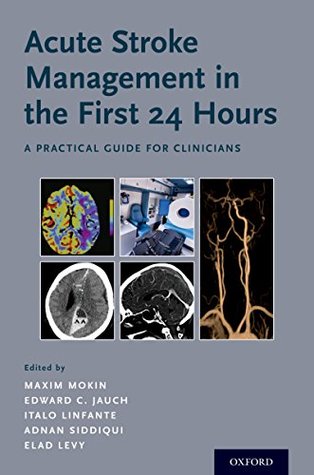Download Acute Stroke Management in the First 24 Hours: A Practical Guide for Clinicians - Maxim Mokin file in ePub
Related searches:
Guidelines for the treatment of acute ischaemic stroke Neurología
Acute Stroke Management in the First 24 Hours: A Practical Guide for Clinicians
Guidelines for the Early Management of Patients With Acute
The Causes of Strokes
Acute Stroke Management in the First 24 Hours - Maxim Mokin
Acute Stroke Management in the First 24 Hours A Practical
Acute Stroke Management in the First 24 Hours 11.50 USD
Guidelines for Early Management of Acute Ischemic Stroke: Key
Managing the Patient with Acute Stroke - Initial Onset and the First
Book Review: Acute Stroke Management in the First 24 Hours: A
Acute Stroke Management in the First 24 Hours 1st Edition
Download Acute Stroke Management in the First 24 Hours : A
Acute stroke management in the first 24 hours: a practical guide for clinicians details. An electronic book, also known as an e-book or ebook, is a book publication.
Acute stroke management in the first 24 hours bridges the clinical application gap by offering a practice-based approach to treating ischemic and hemorrhagic stroke. The comprehensive text, written by international experts in the field of stroke care, covers all aspects of stroke care, including review of stroke systems, clinic features, neuroimaging diagnostic characteristics, and pre-hospital.
Tags: maxim mokin, oxford university press acute stroke management in the first 24 hours (ebook) isbn-13: 9780190856519 additional isbns: 9780190856519, 0190856513 author: maxim mokin.
Acute stroke management in the first 24 hours bridges the clinical application gap by offering a practice-based approach to treating ischemic and hemorrhagic stroke. The comprehensive text, written by international experts in the field of stroke care, covers all aspects of stroke care, including review of stroke systems, clinic features.
The pivotal role of ems in prehospital evaluation and triage of a stroke patient and the levels of stroke systems of care are discussed. In addition, the current guidelines on the management of acute stroke, with the focus on early care of acute stroke patients at the emergency department and the first 24 hours of hospital admission, are reviewed.
The cerebrovascular field has made significant progress toward the goal of preventing and reversing brain injury caused by ischemic or hemorrhagic stroke over t we use cookies to enhance your experience on our website. By continuing to use our website, you are agreeing to our use of cookies.
We may earn commission from links on this page, but we only recommend products we back. Just remember the following: if you're experiencing spasms, weird tics or anythi.
Administration of aspirin is recommended in acute stroke patients within 24-48 hours after stroke onset. For patients treated with iv tpa, aspirin administration is generally delayed for 24 hours.
906 reprinted early screening (24 hours) by a trained professional is strongly recommended.
If you have a condition that affects the blood vessels, such as high blood pressure, heart disease or diabetes, it can raise the chances of your having an eye stroke. They happen the same way other strokes do, by a blockage of blood flow.
Administration of aspirin is recommended in acute stroke patients within 24 to 48 hours after stroke onset. For patients treated with iv tpa, aspirin administration is generally delayed for 24 hours.
50,51 the available data recommend maintaining glycaemia below 155mg/dl and avoiding glucose solutions in the first 24 to 48hours, except in diabetic patients.
Knowing the warning signs and symptoms of a stroke can help you get emergency treatment quickly.
2018 guidelines for the early management of patients with acute ischemic stroke: a guideline for healthcare professionals from the american heart association/american stroke association [published corrections appear in stroke.
This article reviews the literature on the out-of-hospital treatment of stroke patients in studies that focused on the first 24 hours after an acute ischemic stroke,.
There was a greater fall in mean bp in the first 24 hours of treatment (6–9% vs 2 %) and an increase in early and later death in those assigned to β-blockers.
Is ≤110 mmhg prior to treatment and 180/105 mmhg for the first 24 hours after treatment. •for patients with acute ischemic stroke who are not treated with.
Acute ischemic stroke begins with the recognition of stroke iv rtpa and maintained below 180/105 mm hg for at least the first 24 hours after iv rtpa treatment.
Researchers say it's important for people to know the symptoms of a stroke so they can get to a hospital more quickly to begin treatment. Time makes a big difference when it comes to outcomes for people who experience a stroke.
A stroke occurs when blood flow is cut off to parts of the brain either by a blockage or if a blood vessel within the brain ruptures. The cells in the area begin to die, as they aren’t receiving any oxygen.
Managing the patient with acute stroke - initial onset and the first 24 hours describe management priorities following ischemic and hemorrhagic strokes.
Acute stroke management in the first 24 hours can be recommended for anyone looking for a comprehensive summary of the acute management of stroke. However, readers should be aware of the recently revised guidelines and perhaps have a copy available along with the book.
There are many known causes of stroke including conditions that affect brain, heart disease, blood clotting disorders, systemic causes, and illegal drugs. Metrus, md, is board-certified in neurology and neuro-oncology.
Timing, type of drug, and type of patient must be considered. Timing, type of drug, and type of patient must be considered.
Learn about acute strokes, which occur suddenly and should be treated immediately to help reduce the severity of brain damage. Diana apetauerova, md, is board-certified in neurology with a subspecialty in movement disorders.
Acute stroke management in the first 24 hours: a practical guide for clinicians: mokin, assistant professor of neurosurgery and neurology and medical.

Post Your Comments: